Occasionally I rerun a favorite older post but today you get a ‘twofer’ because I’m combining two posts that were published way back in May of 2014. Obviously, I’ve had to rewrite and reorganize much of the text and tweak the formatting. I’ve also changed the title(s) to make the terminology up to date.
On May 20 and 21, 2014 I photographed a behavior called “courtship feeding” in Loggerhead Shrikes on Antelope Island. Cornell’s Birds of the World describes the behavior in shrikes as follows:
“Female accepts prey from male when ready to form a pair bond; such feeding continues throughout incubation and nestling period. Female begs food by crouching, head pointed up, wings drooped and fluttering; silent at first, she gives begging notes as nesting progresses.”
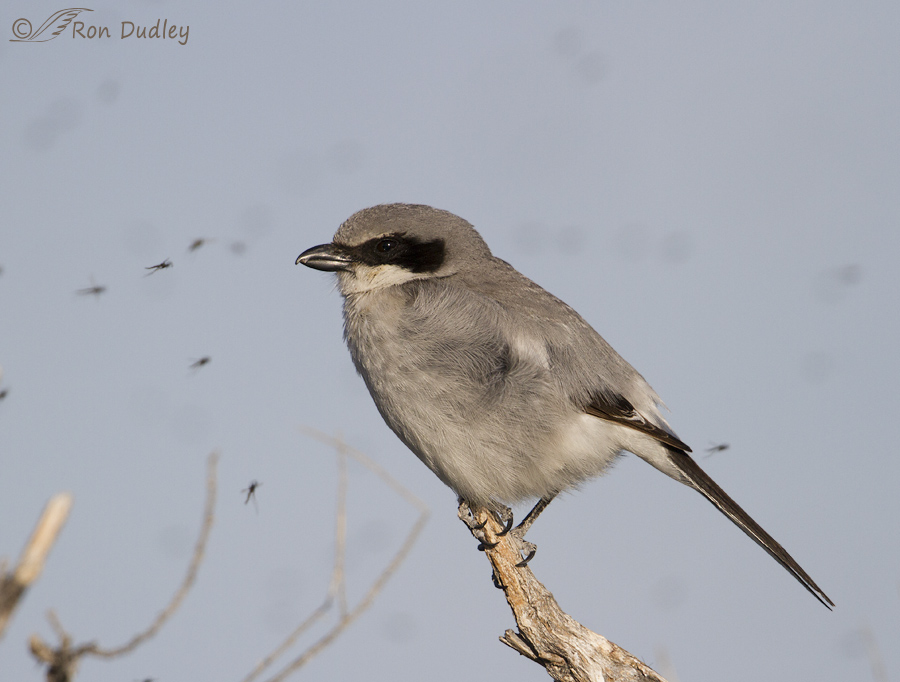
1/3200, f/6.3, ISO 500, Canon 7D, Canon EF500mm f/4L IS II USM +1.4 tc, not baited, set up or called in
On the first morning the midges on the island were thick so they can be seen in all of my photos of the shrikes. Midges don’t bite but they can still be annoying to both photographers and even birds and this female shrike had them flying all around her. She was unusually “sticky” on this perch and at first I didn’t know why she was so reluctant to leave it.
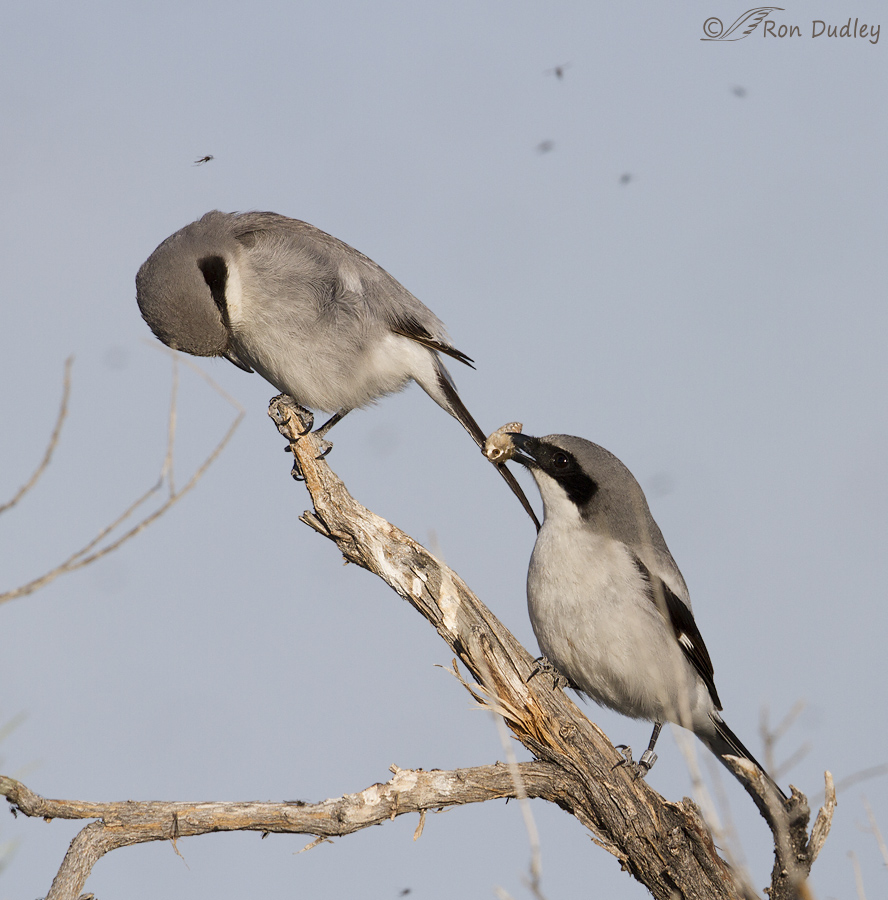
1/4000, f/5.6, ISO 500, Canon 7D, Canon EF500mm f/4L IS II USM, not baited, set up or called in
But it soon became apparent that she was waiting to be fed by her mate. Here he has just flown in with what appears to be a large insect pupa and she shows obvious interest.
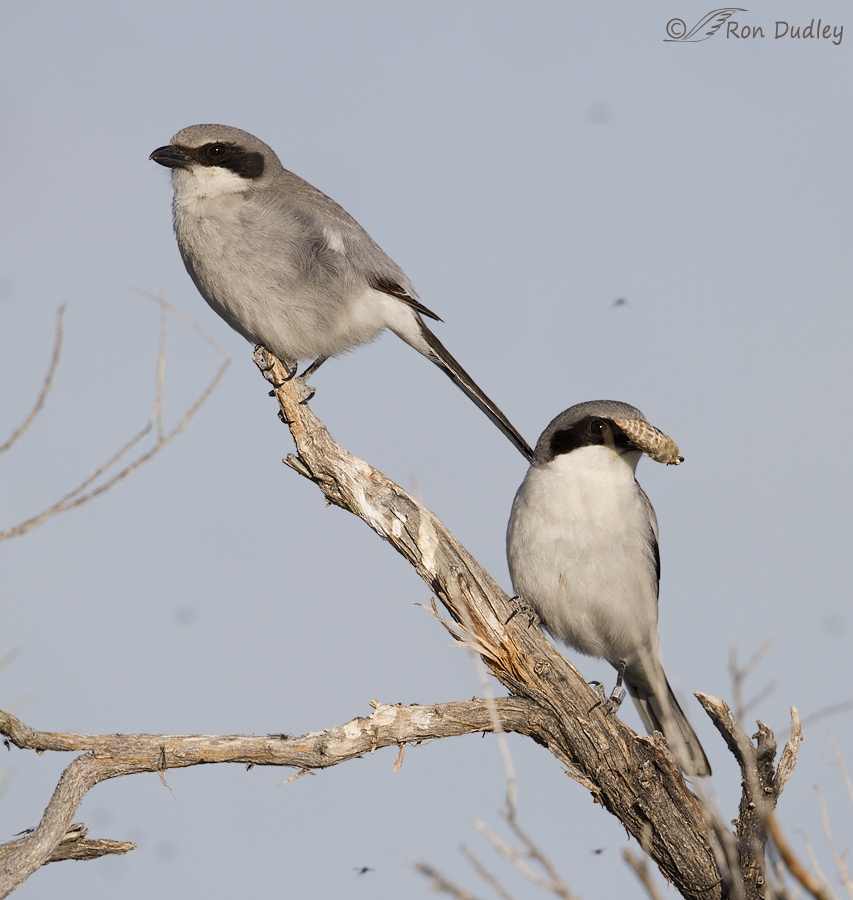
1/3200, f/5.6, ISO 500, Canon 7D, Canon EF500mm f/4L IS II USM, not baited, set up or called in
But then, for a few moments, she seemed unwilling to take the insect which appeared to confuse her mate.
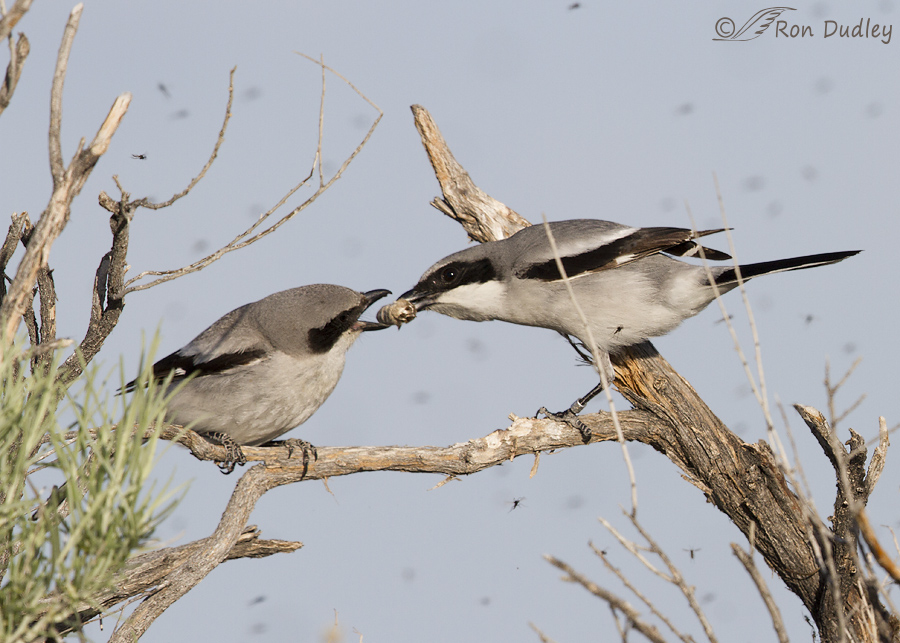
1/1600, f/8, ISO 500, Canon 7D, Canon EF500mm f/4L IS II USM, not baited, set up or called in
But soon she hopped down off her lofty perch to a horizontal branch just below it and took the pupa when it was offered.
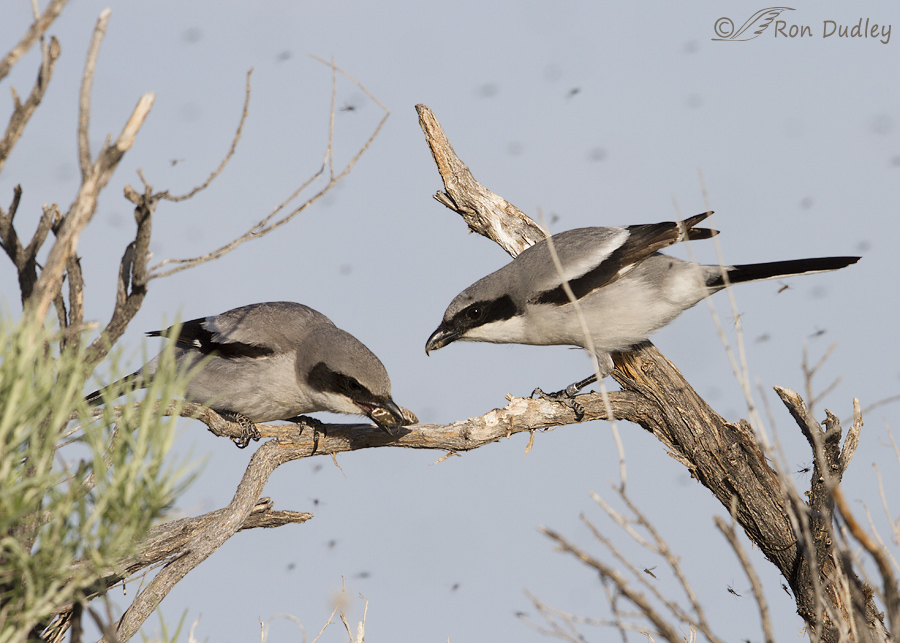
1/1600, f/8, ISO 500, Canon 7D, Canon EF500mm f/4L IS II USM, not baited, set up or called in
She manipulated it with her beak for a few seconds and then flew off with it. I don’t know if she eventually ate it herself or delivered it to possible chicks in the nest
The very next morning (May 21) I returned to the island, and to the same dead branch, in the hopes of finding the shrikes repeating the courtship feeding behavior.
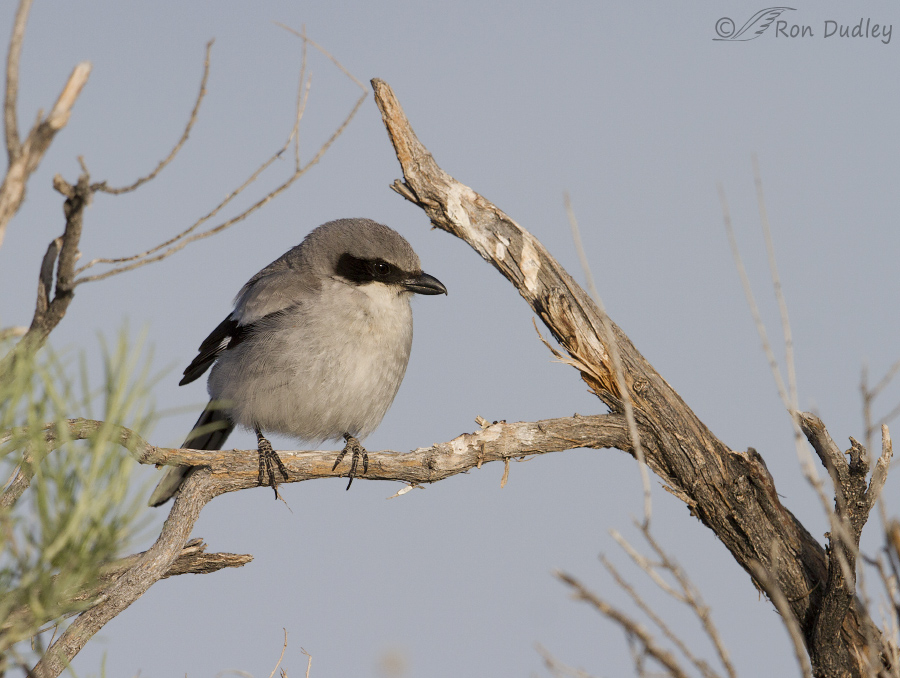
1/3200, f/6.3, ISO 500, Canon 7D, Canon EF500mm f/4L IS II USM, not baited, set up or called in
And there she was, the female was on a different part of the same dead branch as she waited for another food delivery. On this morning there were no midges to speak of.
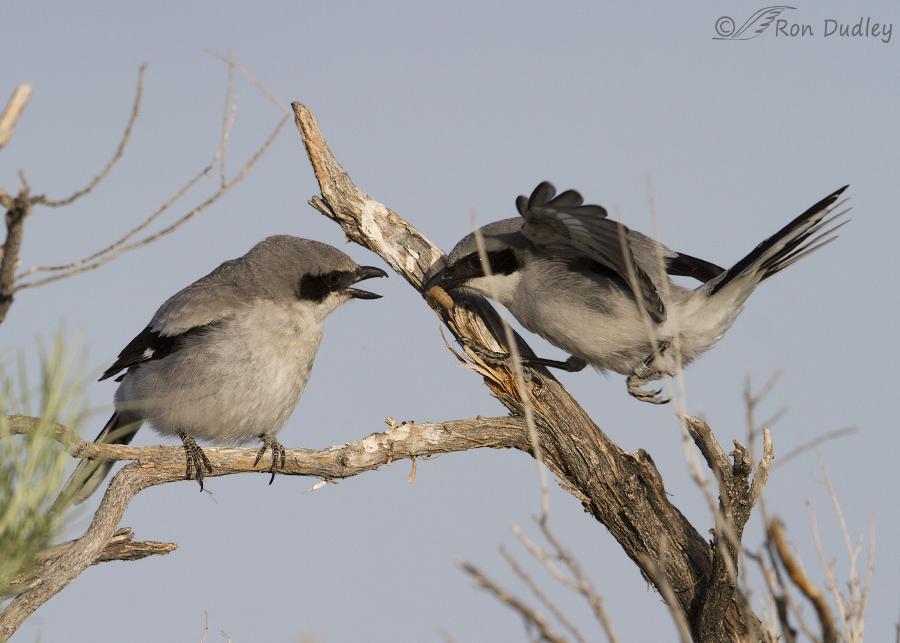
1/3200, f/6.3, ISO 500, Canon 7D, Canon EF500mm f/4L IS II USM, not baited, set up or called in
Soon her mate appeared, this time with an insect larva. You’ll notice that he’s banded so it’s the same pair of shrikes as the previous day. Many of the shrikes on the island had been banded by my friends from the Great Salt Lake Institute (GSLI) out of Westminster College as part of their study of how mercury compounds move through the food chain in and near the Great Salt Lake.

1/3200, f/6.3, ISO 500, Canon 7D, Canon EF500mm f/4L IS II USM, not baited, set up or called in
He offered the insect to her and this time she…
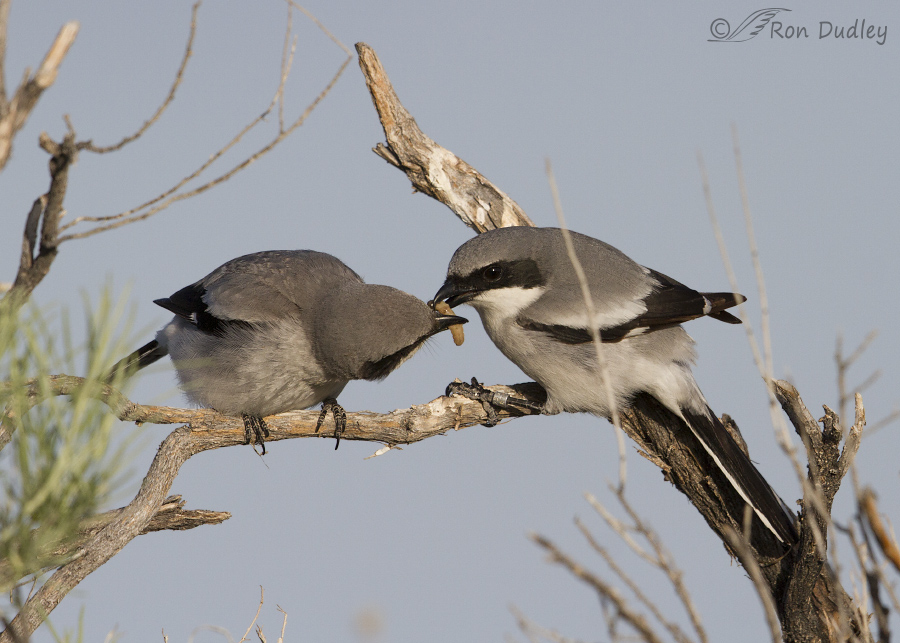
1/3200, f/6.3, ISO 500, Canon 7D, Canon EF500mm f/4L IS II USM, not baited, set up or called in
accepted it immediately and…
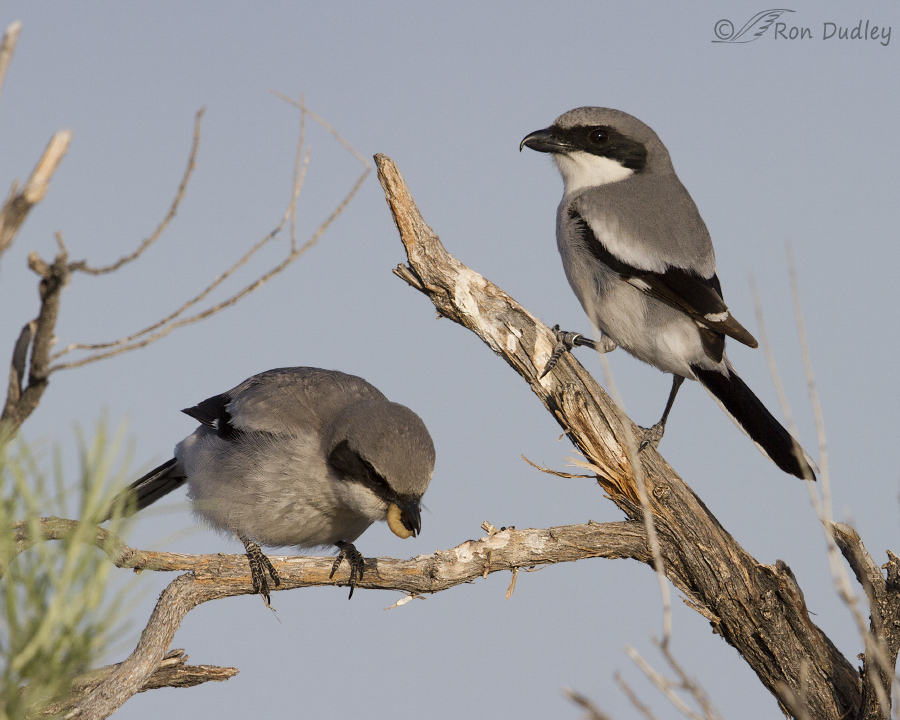
1/3200, f/6.3, ISO 500, Canon 7D, Canon EF500mm f/4L IS II USM, not baited, set up or called in
gobbled it down just as fast. Then both birds flew off at almost the same time.
Because I observed the same behavior on the same perch on two consecutive mornings I began to think of this dead branch as some sort of “feeding station”. The ‘whitewash’ from bird droppings on both forks of the branch seem to reinforce that notion.
Ron


Hmmmm. I’m not sure I’d be married if he offered me grubs!
Sensatopnal series Ron, thanks for sharing!
Charlotte Norton
Thanks, Charlotte.
The way to a young shrike’s heart is through her stomach. These interactions are so easy to anthropomorphize as being sweet and caring — and for that I heartily thank you.
These interactions are so easy to anthropomorphize as being sweet and caring — and for that I heartily thank you.
Who knows, Marty – maybe it isn’t anthropomorphizing…
Just lovely – though it takes more than that to win me over.
A mercury study? Shudder.
Yup, mercury compounds EC. Much of it comes from industry near the lake.
Great behavior capture! Thankfully I just sit at the dinner table and my husband brings yummy food – no begging required!
I’m the cook around here too, Kathleen. And I never require begging.
Ah, that age-old story: Boy meets girl, boy feeds girl, boy gets girl. Wait, is that right? In the bird world perhaps. Beautiful shrikes, however their story goes. I love to see your photos of birds and behaviors I’m unlikely to see up-close-and-personal otherwise.
“Wait, is that right? In the bird world perhaps”
I suspect sometimes it’s ‘right’ in both worlds, Chris.
Another lesson packaged in another series of beautiful photos.
I can relate. I make coffee ready every morning for my wife.
“I make coffee ready every morning for my wife.”
I never did, Michael. Maybe that’s why I’m divorced…
A nice juicy larva or two is all it takes? I wish I had known about this behavior 50 years ago. Could of saved a lot of money on restaurants. Seriously, the way we are overpopulating the planet, bugs may become part of everyone’s diet.
Since it’s been eight years, I wonder what the results of the mercury study discovered.
It was good to hear from Laura Culley. She was an avid commenter when I first came to your blog.
“Seriously, the way we are overpopulating the planet, bugs may become part of everyone’s diet.”
I wouldn’t be surprised, Lyle. IF bugs survive…
See my reply to Carolyn below about the mercury study.
Very interesting series. Do you know what the results of the mercury study were?
Not really, Carolyn. It seems like I remember reading something about them losing funding for the study but don’t quote me on that. I could be wrong.
This series should be up on Cornell’s Birds of the World site. It is informative.
That’s a nice compliment, Sallie. Thank you.
Very interesting and educational Ron. My only encounters with and photos of Shrikes are just a single bird alone on a perch. I learned from you long ago about their raptor like hunting, but had no knowledge about how the male feeds the female. I don’t think your feminist followers are going to like that begging behavior by the female. Good photography and you even got the catch-eye in most of these photos and that is not easy with Shrikes.
Thanks, Everett. I saw several shrikes this morning up north but they didn’t want to have anything to do with me.
Ron
Amazing series of photos, a window into the personal lives of two mutually committed creatures.
Thank you, Bob.
Fun and interesting series, Ron…… Age of part of the post doesn’t phase me a bit – new to me! Intersting how she “debated” about taking the first offering.
Age of part of the post doesn’t phase me a bit – new to me! Intersting how she “debated” about taking the first offering.
Finally had a Belted Kingfisher screaming through the yard last evening – 1st I’ve heard all summer. Late and creek is getting down to puddles so suspect it won’t be here long. Rain in the forecast – we shall see!
I hope you get some of that forecast rain, Judy. We’re dry as a bone around her again. And hot again.
Wonderful post, Ron!! In 2014 I had started watching 3 Bald Eagle nest where one of the bird lovers told me about your page & at that point there was SO little I knew about so many birds that I do now. A friend I made at the Green Cay Wetlands first introduced me to these wonderful Butcher birds that are so interesting in all their behaviors.
Wow, you’re an old-timer when it comes to following FP, Jo Ann. Thanks for sticking around for so long.
Good morning Ron! I’m always delighted to see new photos and also selected ones from years past. This was an amazing “twofer.” In the last picture the male looks so pleased with himself – and who would not. Don’t know why but it reminds me of the line from Ozymandias:
“Look on my Works, ye mighty and despair!’
And good (early) morning to you, Frances. Yeah, he looks like he thinks he’s pretty hot stuff.
I know one shouldn’t anthropomorphize but as a human female of advanced years who has, perhaps unfortunately, had to witness this type of ‘feeding behaviour’ in young human males and females and having seen that same “hot stuff” look I couldn’t help myself; I laughed so hard I almost choked. In birds it serves an evolutionary purpose when there are eggs and young in the nest and predators I suppose but it is hilarious to see it in humans. I so love starting my morning with a laugh and I wonder now if I will always have this image stuck in my brain of shrikes as over the top goofy romantics rather than the somewhat ruthless small time predator image I had previously had of them. Behaviour, human, avian or animal; it’s just so fascinating and a reminder that humans are never that far from our evolutionary roots.


“a reminder that humans are never that far from our evolutionary roots”
Well said, Granny Pat.